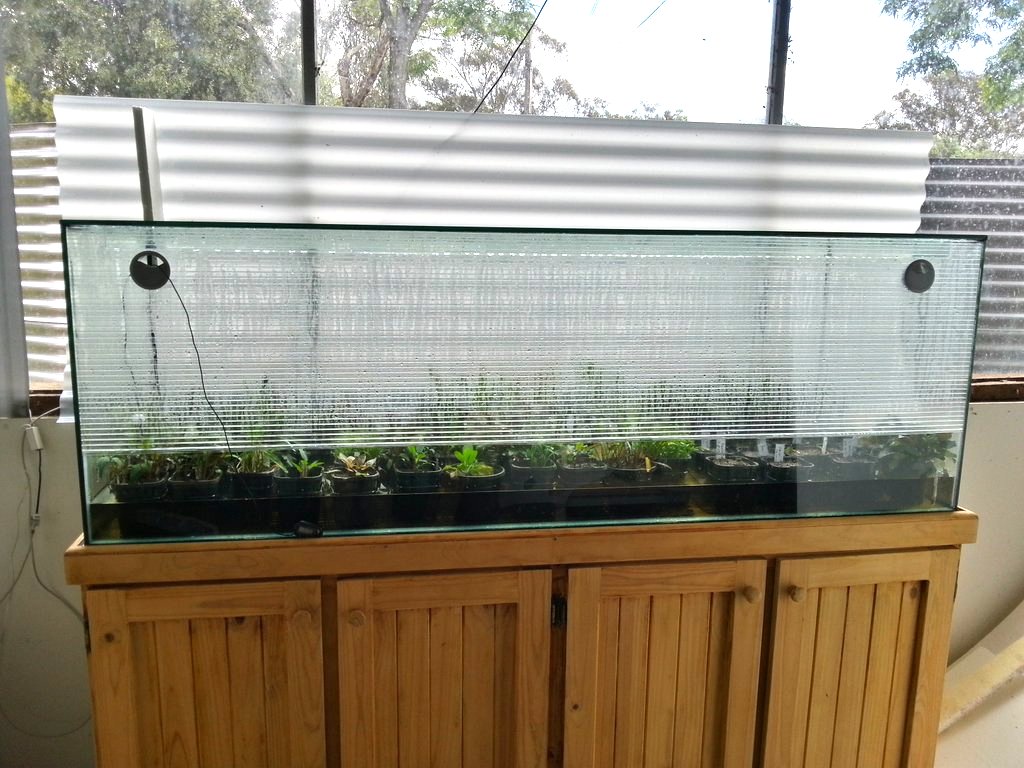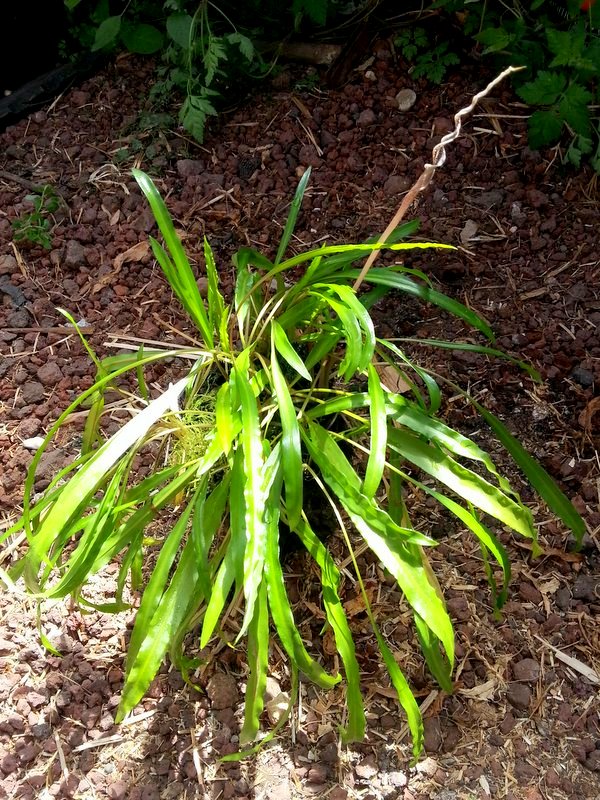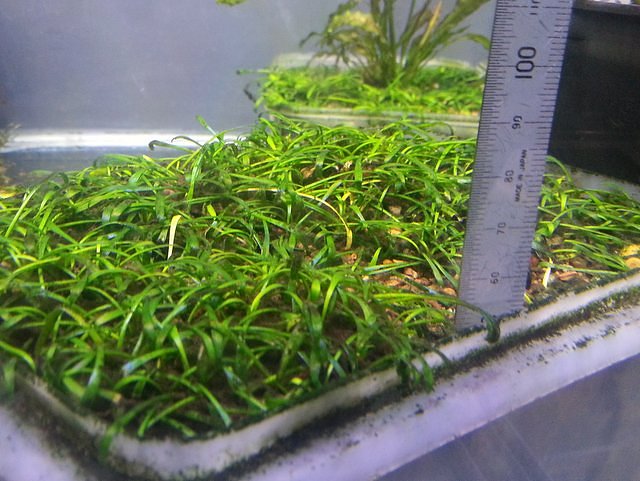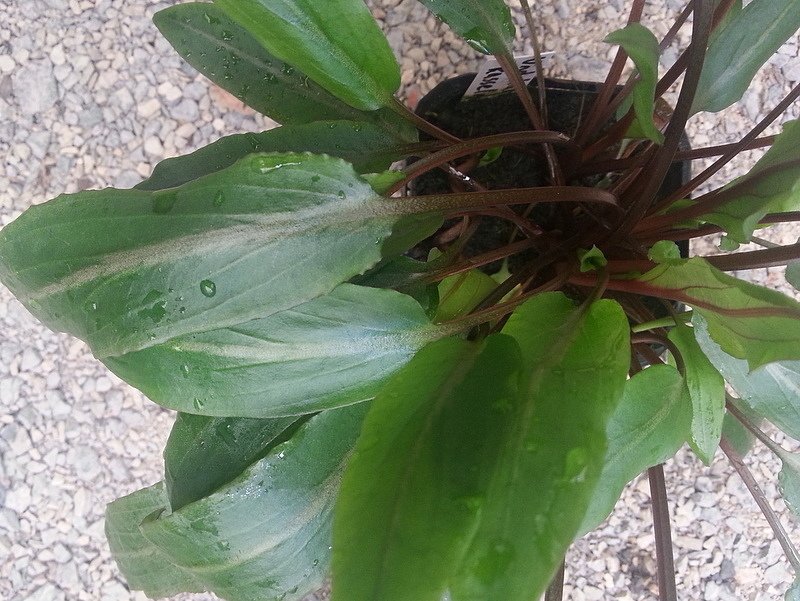A follow up from the previous post to show another spathe
Crypts are interesting and beautiful aquatic plants, but with fewer growers and tight import restrictions we're now losing varieties from cultivation in Australia. I'm propagating crypts to pass on to other growers to keep them in the aquarium hobby and building a resource to help with identification. I'm always looking to buy or swap for new varieties to grow.
Friday, 3 November 2017
Thursday, 2 November 2017
The Cryptarium
Made from a 6x2x2 aquarium that could no longer be used for water because the silicon holding the braces gave way. I removed the bracing and rolled the tank onto its side so the opening is now on the front.
A new piece of polished glass is siliconed across the bottom of the opening to hold the water. The opening is closed off by a piece of twin-wall polycarbonate with a couple of cable grommets installed as vents and handles. On a hot day the afternoon sun through the window was pushing the air temp to 40+C before the vents were installed. Some corrugated translucent polycarbontate sits between the tank and the window to diffuse the direct sun.
To keep it neat and tidy I mounted the heater in a DIY PVC external enclosure in the cabinet. The base of the tank is drilled at each end and bulkheads are installed that allow a loop of 16/22mm hose lagged with closed cell foam to connect the tank to the heater chamber. It works by thermosiphon without a pump. Hot water rises from the heater into the tank at one end and cooler water sinks out of the bulkead at the other end of the tank and circulates back down to the heater. The heater is set to 20C.
This new growing space replaces a couple of the polystyrene boxes I was using.
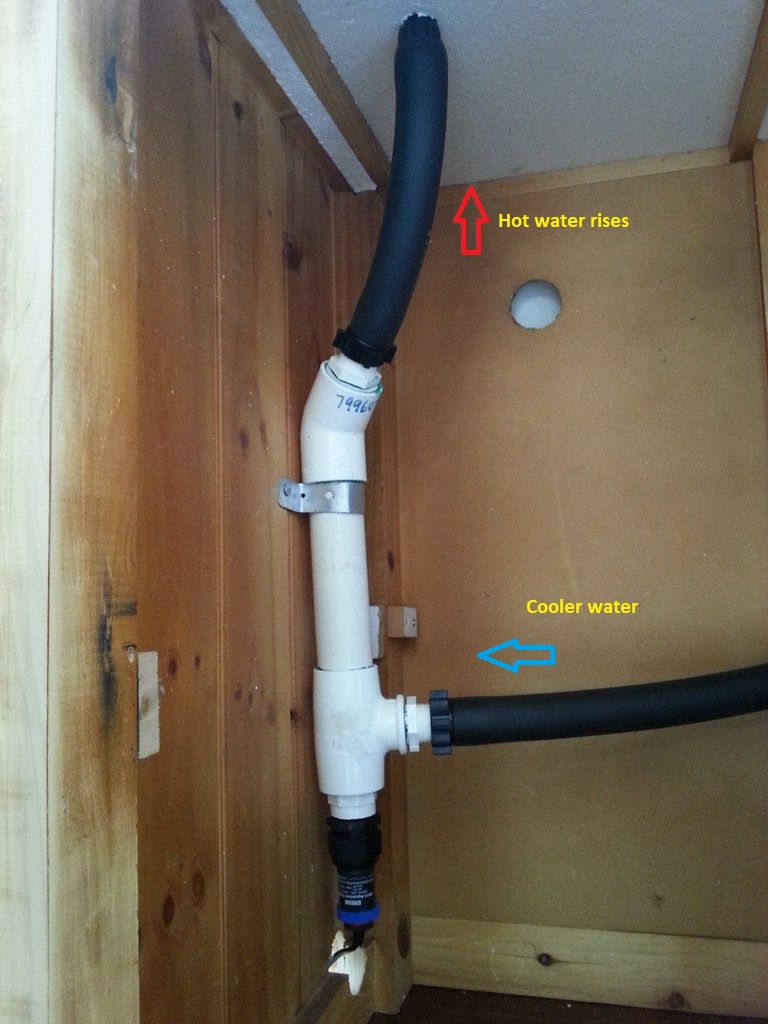
A new piece of polished glass is siliconed across the bottom of the opening to hold the water. The opening is closed off by a piece of twin-wall polycarbonate with a couple of cable grommets installed as vents and handles. On a hot day the afternoon sun through the window was pushing the air temp to 40+C before the vents were installed. Some corrugated translucent polycarbontate sits between the tank and the window to diffuse the direct sun.
To keep it neat and tidy I mounted the heater in a DIY PVC external enclosure in the cabinet. The base of the tank is drilled at each end and bulkheads are installed that allow a loop of 16/22mm hose lagged with closed cell foam to connect the tank to the heater chamber. It works by thermosiphon without a pump. Hot water rises from the heater into the tank at one end and cooler water sinks out of the bulkead at the other end of the tank and circulates back down to the heater. The heater is set to 20C.
This new growing space replaces a couple of the polystyrene boxes I was using.

Wednesday, 1 November 2017
The "Baptism Tub" Cryptarium
A church was selling this "Baptism Tub" on ebay- its a big industrial plastic tub that I've put on a base of milk crates with a timber frame around it to stop it bowing out from the pressure of the water inside. I'm growing crypts on a row of inverted milk crates inside the tub. This allows the tub to hold a large volume of water to help stabilise the temperature. We have vary variable weather here and my glasshouse temperature fluctuates wildly and can get screaming hot in summer. A sheet of greenhouse plastic over the top keeps the warmth and humidity in while its cool... but in summer I'll switch to shadecloth so it breathes a bit better and I have some misters on a timer to cool the air down. In winter I'll have to put a heater in the tub as its common for the water to get below 7C.
Wednesday, 4 October 2017
Cryptocoryne crispatula var. balansae spathe
This is an emersed pot of a generic Crypt . crispatula that came to me unlabelled so at some point I called it 'balanasae' on the basis of the submersed leaves. Emersed the leaves looks a bit like flaccifolia - due the uncertain ID its not a plant I care about so much - but I like to celebrate a spathe and one day I might be more confident with the ID of this one.
Cryptocoryne undulata 'green' (Aquafleur)
Crypt. undulata 'green' distributed in europe by Aquafleur. The spathe looks a little C. wendtii to me but it may not be fully open yet. Its not in the greatest of condition (the pot is infested with blue-green algae) but the leaves are certainly bottle green and appear to stay green under high light. The "regular" C. undulata we have in Australia has a bit more olive green/muddy brown colour.
Cryptocoryne albida 'costata' (Dennerle Cryptocoryne costata)
This variety of Crypt. albida is distributed in europe by Dennerle under the synonym Cryptocoryne costata. It has a very narrow tall "trumpet" with a twist at the top. I have a second plant of this variety that has two older spathes on at the moment that looks the same and didn't unroll further. It seems quite different to another Crypt. albida 'costata' that I obtained from an Australian grower that has much fatter and more open spathes.
Saturday, 2 September 2017
Cryptocoryne cordata var. siamensis "Red Giant"
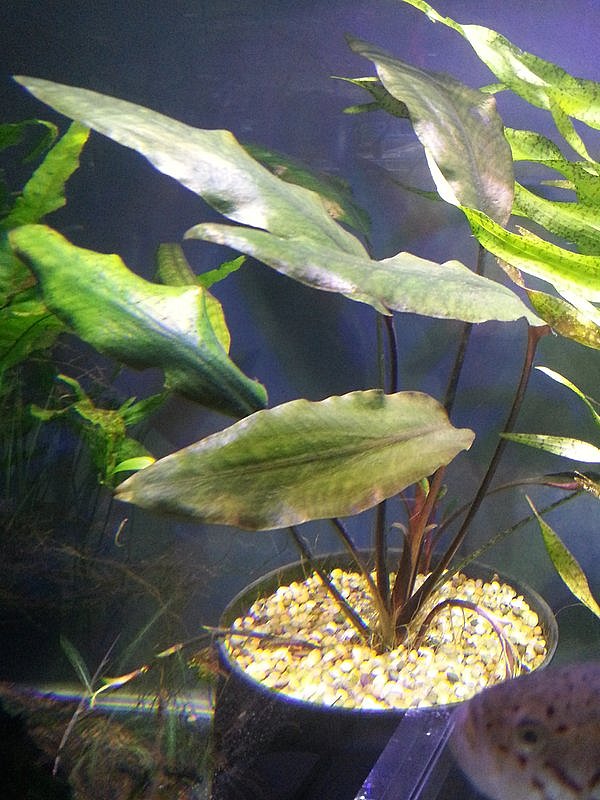 |
"To make a long story short: almost all Cryptocoryne cordata plants in our aquaria today belong to var. siamensis. If you have it growing successfully in your aquarium there is a more than 90% chance that it is var. siamensis. And even if it is not growing well, there is probably still a more than a 90% chance that it is var. siamensis. If it were one of the other varieties of Cryptocoryne cordata it would most likely be dead by now. Of course, if you are one of the few people keeping aquaria with a pH of 4 – 5, you may have something else, but even then there is a good chance that you may have var. siamensis."
Jacobsen, N., and Bastmeijer, J.D. 2014. On Cryptocoryne cordata var. siamensis. Aquatic Gardener 27(3): 29–39.
Friday, 1 September 2017
Cryptocoryne ferruginea update
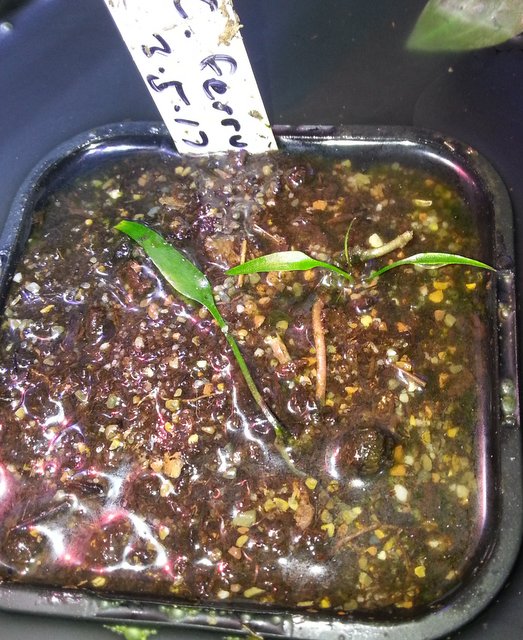
Cryptocoryne aura
Discovered in 2014 and described only last year.
Has beautiful pink and green hues with a very fine transparent "frill" on the leaf margins. So far it seems to grow well with the water just lapping at the leaves. Pictures of Crypt aura in its natural habitat show it growing in shallow water (Russian Blog Aquaflore.ru).
Has beautiful pink and green hues with a very fine transparent "frill" on the leaf margins. So far it seems to grow well with the water just lapping at the leaves. Pictures of Crypt aura in its natural habitat show it growing in shallow water (Russian Blog Aquaflore.ru).
Thursday, 11 May 2017
Cryptocoryne ferruginea needs a helping hand

A couple of decomposing Crypt. ferruginea stalks were given to me in the hope that I can pull them back from dead. Hopefully not too little too late. I know nothing about C. ferruginea other than what I can find online.
From Ipor et al (2006), it is naturally found in acidic conditions with pH 4.6 to 5.5, likes very soft water and shaded conditions.
I loosely bedded the stalks into a mix of sand and composted oak leaves and flooded them with pure rainwater (pH 5.5-6.0, EC 10-20 µS/cm) to the depth you see here. There is a bit of soil in the leaf mix that is initially causing the pH to rise, so I've been draining the pot and reflooding with fresh rainwater every couple of days to maintain acidic conditions. I'm waiting on fresh supplies of peat moss and I may switch them over to a fresh mix with more peat if the pH keeps going up.
Fingers crossed.
Further reading: Ipor, I. B., C. S. Tawan, and M. Basrol. "Growth pattern, biomass allocation and response of Cryptocoryne ferruginea Engler (Araceae) to shading and water depth." Journal of Bioscience 17.2 (2006): 55-78.
Tuesday, 9 May 2017
Cryptocoryne parva submersed vs. emersed
Cryptocoryne parva is a great small crypt from Sri Lanka that is sometimes grown as a carpeting plant in a planted aquarium. Hats off to anyone that achieves this as Crypt parva is a very slow grower so you need patience or to invest in buying lots and planting heavily at the outset. I've seen people closing down a tank sell chunks of "carpet" afterwards for $100+ to be snapped up by the impatient.
The top photo is a slightly manky lunchbox of Crypt parva in one of my tanks. I plant parva around the base of my Aponogetons as it looks good and stops the fish scattering the gravel. Some people think the Crypt roots help oxygenate the substrate. Perhaps thats true... but in this case the Aponogeton died leaving me with a nice crop of parva about 1cm tall. I took a few plants and put them in a pot to grow emersed and they took off.
If you didnt know better you might think the emersed plants are one of the Cryptocoryne ×willisii group that is well known for the characteristically lanceolate leaves on long petioles, or even a dwarf sagittaria. The substrate mix is nothing special - sand, peat moss, and a handfull of shell grit to buffer the pH and add calcium and a handful of composted oak leaves for nutrition
Last year I lost my emersed Crypt parva in winter - tough love in a cold climate. This year the heaters are in early.
Sunday, 9 April 2017
Cryptocoryne cordata var. siamensis 'evae'


The plant pictured was given to me by a long time plant grower who's had this in his plant room for 30+ years as Cryptocoryne evae and has sold it to many enthusiasts over the years under that name.
Cryptocoryne evae and Cryptocoryne blassii are old names that are now considered synonyms Cryptocoryne cordata var. siamensis. Although they are now considered the same species, there can be subtle differences in the varieties that warrent keeping them separate in cultivation. For this reason the full name of the 'blassii' variety is Cryptocoryne cordata var. siamensis 'blassii' and therefore this 'evae' plant is Cryptocoryne cordata var. siamensis 'evae'.
Confusion in crypt taxonomy is not a new thing and there is more than one online database that still uses the "evae" name.
The source grower thinks the underside of the leaves may be paler red (more green) when compared to blassii, but that could also result from growing conditions (and that red leaf bottom left looks very much like my blassii). I'll grow evae side-by-side with blassii and see if any differences are maintained.
Wednesday, 5 April 2017
Cryptocoryne moehlmannii
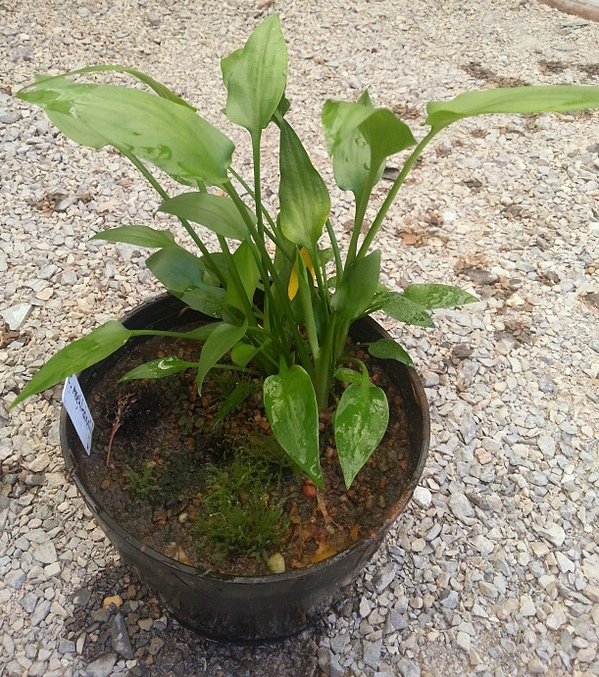

Crypt. moehlmannii looks similar to Crypt. noritoi and Crypt. pontederiifolia so really need to make sure they are labelled clearly. There are subtle differences in colour and the ridges on the leaves and moehlmannii is a little "pointier" then noritoi.
Cryptocoryne crispatula var. kubotae

Tuesday, 4 April 2017
Cryptocoryne wendtii 'flamingo'


Saturday, 1 April 2017
Oak leaf mould


I've been using the oak leaf mould to replace some or all of the peat moss in a mix that is about 40% peat/oak, 50% sand and 10% red clay and shell grit. We don't have many "blackwater" crypts in Australia that grow in pure leaf mould, but if they ever get here I'm ready.
Update: May 2017. The pH of the mix is approx 7.2 so not acidic at all and not the best for the true blackwater crypts. I certainly do think its benficial to the mix, but for species that need pH <6.0 this isn't going to do it... at least not in the form it is here. I've got some in jars with Crypt cordata that have been festering as a slurry with water for a longer period of time and these are more acidic. It might take a couple of months in water for the organic acids to really do their thing.
Tuesday, 28 March 2017
Cryptocoryne ciliata var. latifolia

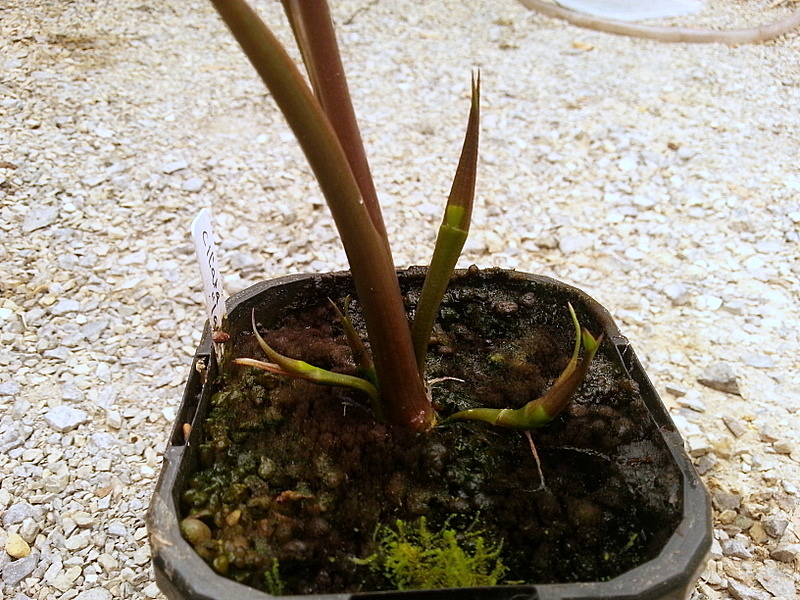
New runners and hopefully a flower forming. Crypt ciliata in the wild is more of a brackish mudflat plant so tends not to be common in aquaria. I have one submersed also but its nowhere near as healthy and vigorous.
End of summer 16/17
Photo update of my emersed crypts before I move them from their suymmer "shed" back to the glasshouse for winter. The boxes are slowly multiplying - my goal is to have a couple of pots of each variety and after that any extras I can propagate will be distributed to other collectors first (off-site backups!) and then to whomever shows an interest. There are 4 tanks of submersed crypts inside too. OTT? maybe.


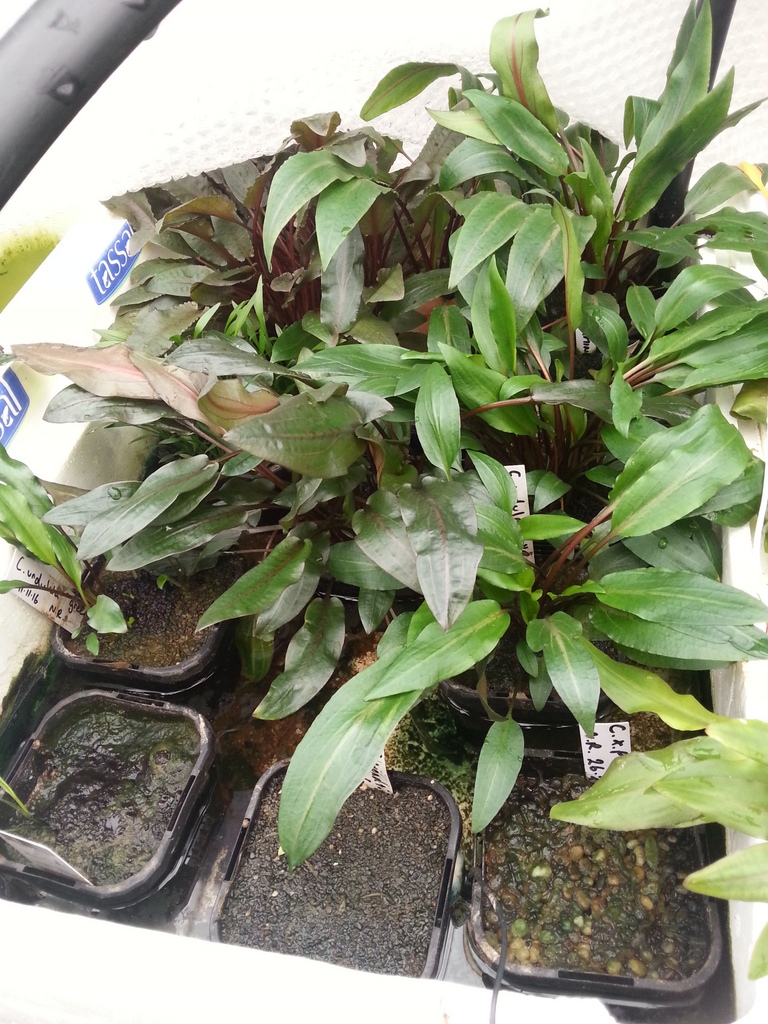
Above: Mostly Cryptocoryne undulata varieties in a new potting mix that is working really well (sand, clay, peat, a handful of shell grit, and composted oak leaves) - notice the dark greens. Growth has been great in these pots and I think composted oak leaves have improved the mix.
 Above: Older pots (a little yellowing suggests more ferts needed) mostly C. wendtii to the left, C. cordata to the right, C. albida varieties in the back, C. crispatula var. kubutae is the grassy one in the middle.
Above: Older pots (a little yellowing suggests more ferts needed) mostly C. wendtii to the left, C. cordata to the right, C. albida varieties in the back, C. crispatula var. kubutae is the grassy one in the middle.

Above: Mostly C. spiralis in the back (lots of flowers at the moment but not really visible in the pics), C. crispatula varieties in the front. Again notice the yellowing of some of the plants suggesting the nutrients in the pots are exhausted - crypts are heavy feeders and these post have been going for more than a year. I've started putting just a little of my aquarium fert and trace mix into the water.

Above: Bits of this and that - C. wendtii varieties in the back, C. crispatula var balanasae poking through... A lovely pink C. pontederiifolia front left and closeup below.

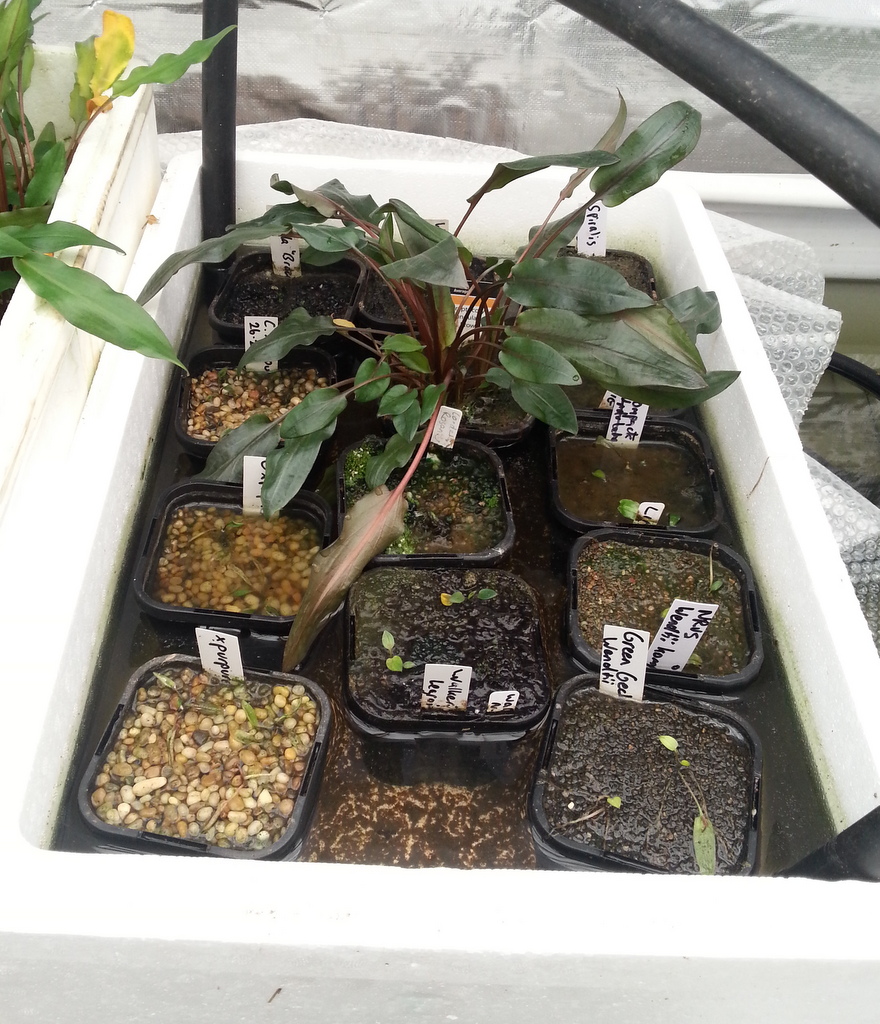


Cryptocoryne cilliata var. latifolia - finally happy after nursing it along for a year or more, two other pots all rotted away. I have one submersed also (not going so great but stable). It looks like I have some runners forming and also maybe... a flower! I love the hairy flowers from these and have not seen one that was grown in Australia before - see pics on the Crypt Pages



Above: Mostly Cryptocoryne undulata varieties in a new potting mix that is working really well (sand, clay, peat, a handful of shell grit, and composted oak leaves) - notice the dark greens. Growth has been great in these pots and I think composted oak leaves have improved the mix.
 Above: Older pots (a little yellowing suggests more ferts needed) mostly C. wendtii to the left, C. cordata to the right, C. albida varieties in the back, C. crispatula var. kubutae is the grassy one in the middle.
Above: Older pots (a little yellowing suggests more ferts needed) mostly C. wendtii to the left, C. cordata to the right, C. albida varieties in the back, C. crispatula var. kubutae is the grassy one in the middle.
Above: Mostly C. spiralis in the back (lots of flowers at the moment but not really visible in the pics), C. crispatula varieties in the front. Again notice the yellowing of some of the plants suggesting the nutrients in the pots are exhausted - crypts are heavy feeders and these post have been going for more than a year. I've started putting just a little of my aquarium fert and trace mix into the water.

Above: Bits of this and that - C. wendtii varieties in the back, C. crispatula var balanasae poking through... A lovely pink C. pontederiifolia front left and closeup below.




Cryptocoryne cilliata var. latifolia - finally happy after nursing it along for a year or more, two other pots all rotted away. I have one submersed also (not going so great but stable). It looks like I have some runners forming and also maybe... a flower! I love the hairy flowers from these and have not seen one that was grown in Australia before - see pics on the Crypt Pages
Subscribe to:
Comments (Atom)

